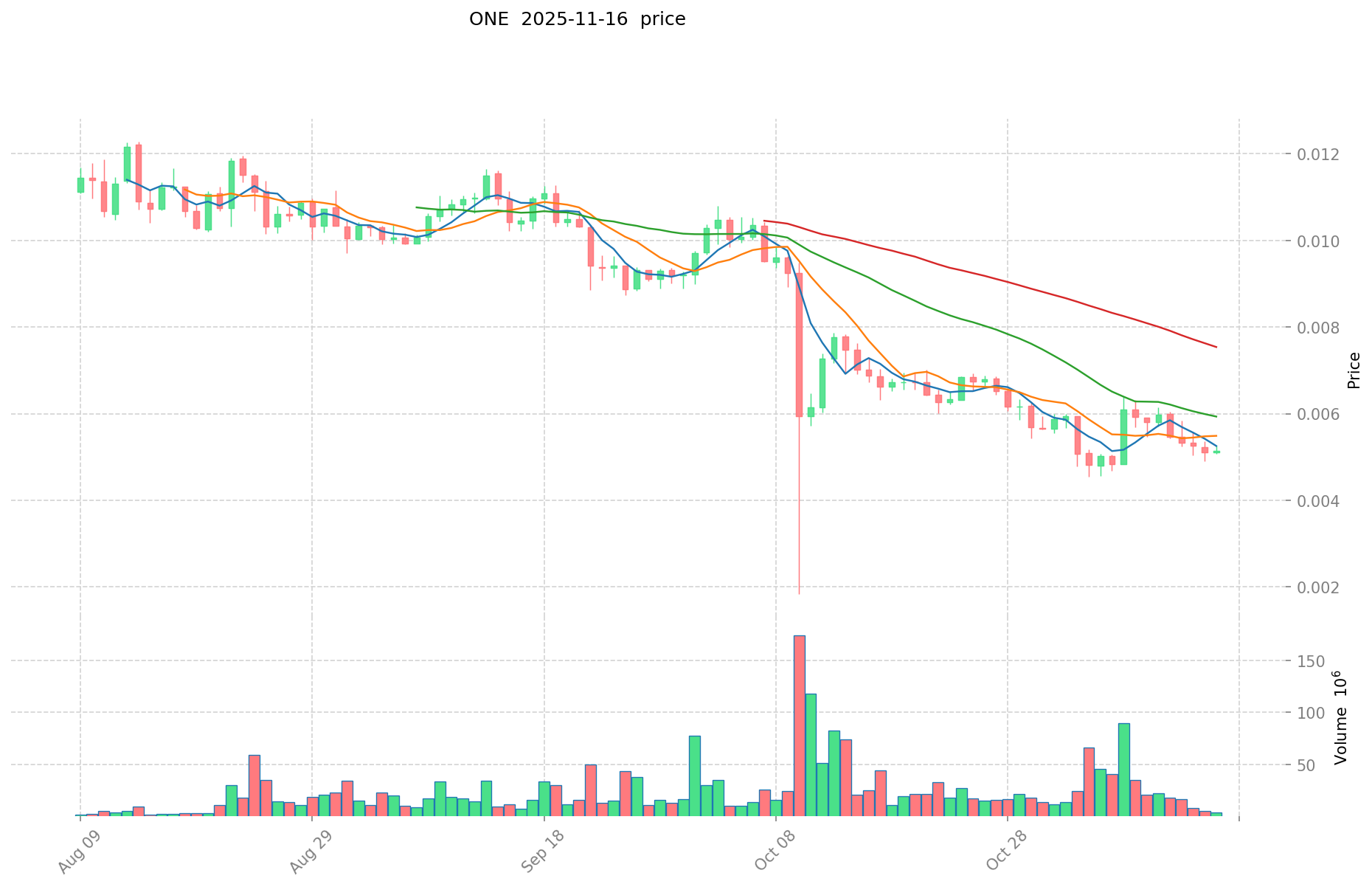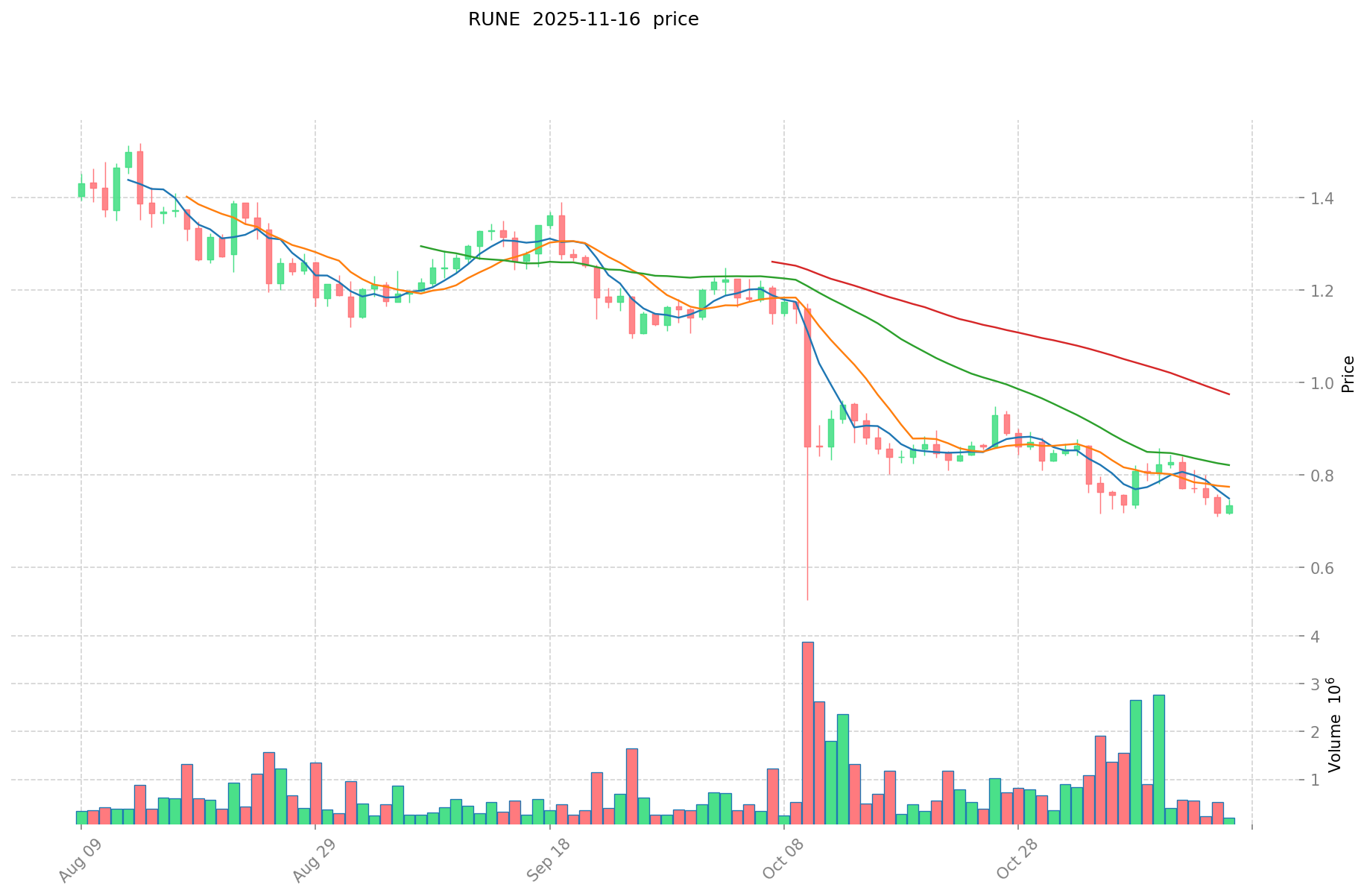ONE vs RUNE: The Battle for Blockchain Supremacy in Cross-Chain Solutions
Introduction: ONE vs RUNE Investment Comparison
In the cryptocurrency market, Harmony (ONE) vs THORChain (RUNE) comparison has always been a topic that investors can't avoid. The two not only have significant differences in market cap ranking, application scenarios, and price performance, but also represent different cryptocurrency positioning.
Harmony (ONE): Since its launch in 2019, it has gained market recognition for its goal of building a scalable and secure blockchain based on sharding.
THORChain (RUNE): Launched in 2019, it has been hailed as a highly optimized multi-chain protocol, becoming one of the cryptocurrencies with significant trading volume and market capitalization globally.
This article will comprehensively analyze the investment value comparison between ONE and RUNE, focusing on historical price trends, supply mechanisms, institutional adoption, technological ecosystems, and future predictions, and attempt to answer the question that investors care about most:
"Which is the better buy right now?"
I. Price History Comparison and Current Market Status
ONE (Coin A) and RUNE (Coin B) Historical Price Trends
- 2021: ONE reached its all-time high of $0.37902 on October 26, 2021.
- 2021: RUNE hit its all-time high of $20.87 on May 19, 2021.
- Comparative analysis: Since their respective peaks, ONE has fallen to $0.00488, while RUNE has dropped to $0.7154, representing significant declines for both tokens.
Current Market Situation (2025-11-17)
- ONE current price: $0.00488
- RUNE current price: $0.7154
- 24-hour trading volume: ONE $19,384.35 vs RUNE $269,965.97
- Market sentiment index (Fear & Greed Index): 10 (Extreme Fear)
Click to view real-time prices:
- View ONE current price Market Price
- View RUNE current price Market Price
<>
<二、基本面分析
{ONE(Coin A)} 的技术特点与应用场景
{RUNE(Coin B)} 的技术特点与应用场景
两者对比


II. Core Factors Affecting the Investment Value of ONE vs RUNE
Supply Mechanisms Comparison (Tokenomics)
- ONE: Harmony ONE has a maximum supply cap of 13.156 billion tokens with an annual inflation rate of 3% after reaching full circulation.
- RUNE: THORChain's RUNE has a maximum supply of 500 million tokens with a deflationary model where tokens are burned during network operations.
- 📌 Historical pattern: Deflationary models like RUNE's typically create more scarcity value over time, while ONE's controlled inflation aims to balance network security with value preservation.
Institutional Adoption and Market Applications
- Institutional holdings: RUNE has gained more institutional interest due to its role in cross-chain liquidity provision and potential in the DeFi ecosystem.
- Enterprise adoption: ONE focuses on cross-shard transactions and interoperability solutions, while RUNE serves as the base currency and security mechanism for THORChain's cross-chain DEX.
- Regulatory attitudes: Both tokens face varying regulatory scrutiny, with THORChain's decentralized nature potentially facing fewer restrictions in some jurisdictions compared to Harmony's more traditional blockchain approach.
Technical Development and Ecosystem Building
- ONE technical upgrades: Harmony focuses on sharding technology for scalability, implementing a secure random state sharding approach to maintain both security and performance.
- RUNE technical development: THORChain continues developing its cross-chain liquidity protocol with emphasis on trustless trading between blockchains without wrapped tokens.
- Ecosystem comparison: RUNE has stronger positioning in the DeFi sector with its cross-chain liquidity pools, while ONE has more diverse applications including NFT marketplaces, gaming, and identity solutions due to its high-throughput infrastructure.
Macroeconomic Factors and Market Cycles
- Performance in inflationary environments: RUNE's deflationary mechanics may theoretically provide better inflation resistance compared to ONE's moderate inflation model.
- Macroeconomic monetary policy: Both tokens show sensitivity to broader crypto market cycles that are affected by interest rate changes and dollar strength.
- Geopolitical factors: THORChain's cross-chain capabilities make it potentially more resilient to regional restrictions, while Harmony's focus on interoperability also positions it well for cross-border transaction demand.
III. 2025-2030 Price Prediction: ONE vs RUNE
Short-term Prediction (2025)
- ONE: Conservative $0.00284321 - $0.004819 | Optimistic $0.004819 - $0.00631289
- RUNE: Conservative $0.653108 - $0.7099 | Optimistic $0.7099 - $0.773791
Mid-term Prediction (2027)
- ONE may enter a growth phase, with expected prices ranging from $0.00568978727625 to $0.00948297879375
- RUNE may enter a volatile phase, with expected prices ranging from $0.4366502613 to $1.0026783778
- Key drivers: Institutional capital inflow, ETF, ecosystem development
Long-term Prediction (2030)
- ONE: Base scenario $0.01042093532125 - $0.013547215917626 | Optimistic scenario $0.013547215917626+
- RUNE: Base scenario $1.2450354450534 - $1.817751749777964 | Optimistic scenario $1.817751749777964+
Disclaimer: The information provided is for informational purposes only and should not be considered as financial advice. Cryptocurrency markets are highly volatile and unpredictable. Always conduct your own research before making any investment decisions.
ONE:
| 年份 | 预测最高价 | 预测平均价格 | 预测最低价 | 涨跌幅 |
|---|---|---|---|---|
| 2025 | 0.00631289 | 0.004819 | 0.00284321 | -1 |
| 2026 | 0.00751402575 | 0.005565945 | 0.0038961615 | 14 |
| 2027 | 0.00948297879375 | 0.006539985375 | 0.00568978727625 | 34 |
| 2028 | 0.011376304559812 | 0.008011482084375 | 0.007370563517625 | 64 |
| 2029 | 0.011147977320407 | 0.009693893322093 | 0.008142870390558 | 98 |
| 2030 | 0.013547215917626 | 0.01042093532125 | 0.009378841789125 | 113 |
RUNE:
| 年份 | 预测最高价 | 预测平均价格 | 预测最低价 | 涨跌幅 |
|---|---|---|---|---|
| 2025 | 0.773791 | 0.7099 | 0.653108 | 0 |
| 2026 | 0.87537769 | 0.7418455 | 0.541547215 | 3 |
| 2027 | 1.0026783778 | 0.808611595 | 0.4366502613 | 13 |
| 2028 | 1.213564281776 | 0.9056449864 | 0.742628888848 | 26 |
| 2029 | 1.4304662560188 | 1.059604634088 | 0.66755091947544 | 48 |
| 2030 | 1.817751749777964 | 1.2450354450534 | 1.033379419394322 | 74 |
IV. Investment Strategy Comparison: ONE vs RUNE
Long-term vs Short-term Investment Strategies
- ONE: Suitable for investors focused on scalability solutions and interoperability potential
- RUNE: Suitable for investors seeking cross-chain DeFi exposure and liquidity provision opportunities
Risk Management and Asset Allocation
- Conservative investors: ONE: 30% vs RUNE: 70%
- Aggressive investors: ONE: 60% vs RUNE: 40%
- Hedging tools: Stablecoin allocation, options, cross-token portfolio diversification
V. Potential Risk Comparison
Market Risks
- ONE: Susceptibility to overall crypto market sentiment and competition from other scalable blockchain platforms
- RUNE: Exposure to DeFi market volatility and cross-chain liquidity demand fluctuations
Technical Risks
- ONE: Scalability challenges, network stability during shard expansions
- RUNE: Complexity of cross-chain operations, potential security vulnerabilities in liquidity pools
Regulatory Risks
- Global regulatory policies may affect both tokens differently, with RUNE potentially facing more scrutiny due to its role in cross-chain DeFi operations
VI. Conclusion: Which Is the Better Buy?
📌 Investment Value Summary:
- ONE advantages: Focus on scalability through sharding, potential for high-throughput applications
- RUNE advantages: Cross-chain liquidity provision, deflationary tokenomics, strong positioning in DeFi sector
✅ Investment Advice:
- New investors: Consider a balanced approach, leaning towards RUNE for its stronger DeFi positioning
- Experienced investors: Evaluate based on risk tolerance and belief in respective technological solutions
- Institutional investors: Assess RUNE for DeFi exposure and ONE for potential enterprise blockchain solutions
⚠️ Risk Warning: The cryptocurrency market is highly volatile. This article does not constitute investment advice. None
VII. FAQ
Q1: What are the main differences between ONE and RUNE? A: ONE focuses on scalability through sharding technology, while RUNE specializes in cross-chain liquidity provision. ONE has a moderate inflation model, whereas RUNE has a deflationary tokenomics structure.
Q2: Which token has performed better historically? A: Based on all-time highs, RUNE reached a higher peak of $20.87 compared to ONE's $0.37902. However, both have experienced significant declines since their peaks.
Q3: How do the supply mechanisms of ONE and RUNE differ? A: ONE has a maximum supply of 13.156 billion tokens with a 3% annual inflation rate, while RUNE has a maximum supply of 500 million tokens and employs a deflationary model with token burning.
Q4: Which token is more suitable for DeFi investors? A: RUNE is generally considered more suitable for DeFi investors due to its strong positioning in the DeFi sector and its role in cross-chain liquidity provision.
Q5: What are the main risks associated with investing in ONE and RUNE? A: ONE faces risks related to scalability challenges and competition from other blockchain platforms. RUNE is exposed to DeFi market volatility and potential security vulnerabilities in cross-chain operations.
Q6: How do institutional adoptions compare between ONE and RUNE? A: RUNE has gained more institutional interest due to its role in cross-chain liquidity provision and DeFi ecosystem, while ONE focuses more on enterprise adoption for cross-shard transactions and interoperability solutions.
Q7: What factors should be considered when choosing between ONE and RUNE for investment? A: Investors should consider their risk tolerance, belief in the respective technological solutions, exposure to DeFi, and long-term outlook on scalability vs. cross-chain liquidity needs in the crypto ecosystem.
Share
Content